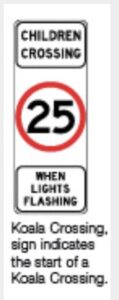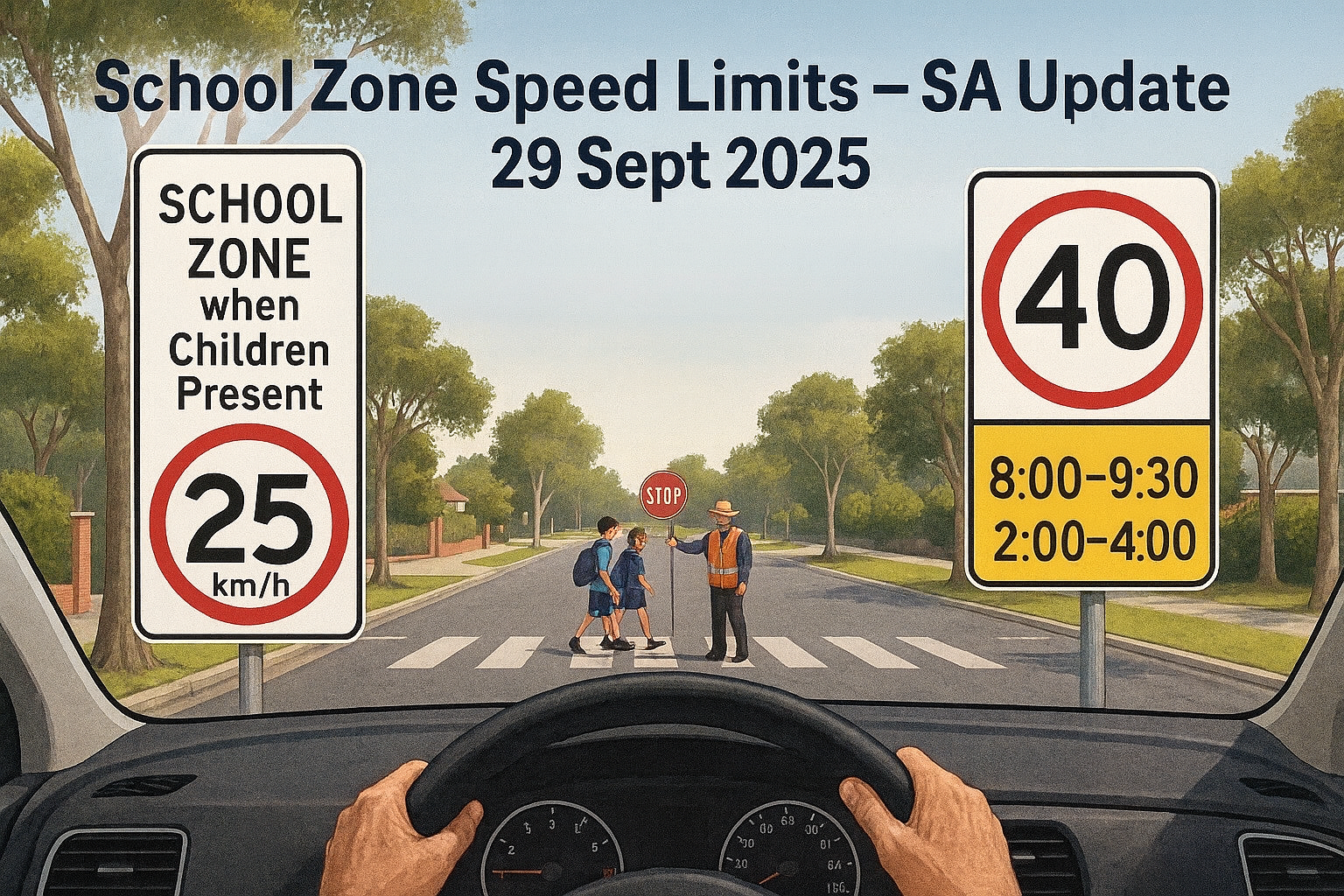(From 29 September 2025, rolling out across all schools)
To improve student safety at drop-off and pick-up times, the South Australian Government will introduce new speed rules starting 29 September 2025. These changes will gradually expand across schools statewide, with around 150 schools covered by the end of 2026.
This guide combines official information from the Department for Infrastructure and Transport (DIT) with existing rules explained in the Australian Road Rules.
1. Existing School Zone Rules (still in place)
Situation 1: “When Children Present” Signs
- In zones marked “School Zone when Children Present”, you must slow down to 25 km/h whenever children are present.
- “Children present” means anyone under 18, or wearing school uniform, or otherwise clearly identifiable as a student.
- This includes children on footpaths, on the road, in the median strip, or riding bicycles.
- The 25 km/h limit applies until you pass the “End of School Zone” sign.

Situation 2: Flashing Lights
- In zones with yellow flashing lights, the 25 km/h speed limit applies whenever the lights are flashing.
- Again, the limit continues until you pass the “End of School Zone” sign.

Situation 3: “Children Crossing” Flags
- When red “Children Crossing” flags are raised near a school crossing or zebra crossing:
- All vehicles must slow to 25 km/h.
- Crossing supervisors (lollipop people): If a supervisor raises the STOP sign, you must come to a complete stop and only continue when directed.
- Without a supervisor: If any pedestrian approaches the crossing, you must stop and give way.
- Even though the flag says “Children Crossing”, the rule applies to all pedestrians, including adults.
2. New Rules from 29 September 2025
Background
- The SA Government has decided to reduce speed limits on certain major roads near schools to 40 km/h during school peak times.
- This is an addition to the existing 25 km/h school zones, not a replacement.
Implementation
- Begins 29 September 2025, rolling out progressively until the end of 2026.
- Around 150 schools across the state will be included.
- First schools: Marryatville High School, Goodwood Primary, St Thomas School.
Operating Times
- Only applies on school days, during:
- 8:00–9:30 am
- 2:00–4:00 pm
- Not in force on weekends, public holidays, or school holidays.
Enforcement
- New signs and electronic speed signs will be installed.
- Some sites will also have upgraded safety cameras.
3. Understanding the Difference: 25 km/h vs 40 km/h
- 25 km/h school zones (existing)
- Found mostly on local or side streets next to schools.
- Always applies whenever children are present, lights are flashing, or flags are raised.
- 40 km/h major road zones (new from 29 Sept 2025)
- Found on busy main roads outside or near schools.
- Only applies during the specified times (8:00–9:30 am, 2:00–4:00 pm on school days).
- Outside those hours, normal road speed limits apply.
4. Driver Reminders
- Always slow early and stay alert when approaching school areas.
- Check the signs carefully – different rules may apply depending on the location and the time.
- 25 km/h School Zone → if children are present, lights flashing, or flags raised.
- 40 km/h Zone → only during the specified school peak times.
- Watch for electronic signs and safety cameras.
- Always stop and give way to pedestrians at crossings, with or without a supervisor.
Summary
From 29 September 2025, South Australia will have a dual school zone system:
- 25 km/h (existing rule) – applies whenever children are present, lights flashing, or flags are displayed.
- 40 km/h (new rule) – applies on major roads near schools, during morning and afternoon peak times on school days.
By 2026, both systems will cover schools across the state. This layered approach ensures greater safety for children and families on both local streets and major roads.
References
- Department for Infrastructure and Transport (DIT): Protecting students with a lower speed limit
- Australian Road Rules 23
- Australian Road Rules 80

